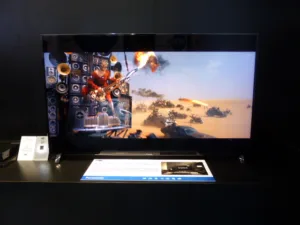Panasonic had one of the more interesting stands at the show, although it wasn’t easy to track down all of the new displays. The company has a presence in so many product areas, including automotive, health and battery technology, that new developments were spread out all over the place.
Two UltraHD TVs were on show, along with an UltraHD Blu-ray player. One of the sets was the CZ950 OLED set, seen at IFA last year (Panasonic Joins the Exclusive OLED TV Club), but the other – an LCD model – was new for the show. This is the DX900, which was the first TV in the world to be certified by the UltraHD Association as ‘UltraHD Premium’.
Like the CZ950, the DX900 has been graded by Hollywood colourist Mike Sowa, to ensure that it is as accurate as possible. It was developed with Panasonic’s Hollywood Laboratory, and is THX certified. The TV is HDR-capable and uses a new ‘honeycomb’ structure, which enables hundreds of local dimming zones. Panasonic says that light leakage between these zones is minimised – a key for HDR. Peak brightness reaches 1,000 cd/m².
Panasonic’s 3D Look Up Table and new HCX+ (Hollywood Cinema eXperience Plus) technologies are built in to the TV. The 3D LUT handles the colour demands of HDR, while the HCX+ processor ensures that this content is mapped to the screen as accurately as possible. The processor delivers an enhanced version of the 3D LUT, covering 3,000 registry reference points.
The DX900 will be available in 58″ and 65″ sizes. Smart functionality will be provided by the Firefox OS. The TV will be sold in Europe in March; a US launch is TBD.
Like the DX900, the DMP-UB900 Blu-ray player is THX certified. It supports HDR content, and uses ‘proprietary chroma and gradation processing’, refined by the Hollywood Laboratory. The plan is also for the player to support UltraHD VoD services.
According to the company, the UB900 uses a new engine called the 4k High-Precision Chroma Processor. This interpolates the decoded UltraHD (4:2:0) signals of UltraHD Blu-ray content to UltraHD (4:4:4). A chroma upscaling function is also included. DLNA and Miracast are also featured. UltraHD content can be output at up to 60fps.
An addition to Panasonic’s Toughpad tablet line was also being shown. The 12.5″ FZ-Q1 has 1920 x 1080 resolution, and will be available in two models: Performance and Standard. Differences come in the processor, RAM, storage and OS.
The FZ-Q1 Performance has a Core i5 processor running Windows 8.1 Pro or Windows 7 Pro, with 8GB of RAM and a 128GB/256GB SSD. The Standard edition uses an Intel Celeron processor, Windows 8.1 Pro, 4GB of RAM and 64GB flash storage, or a 128GB SSD.
Both models have 350 cd/m² of brightness, an anti-reflective screen and a fanless design. The battery is a fast-charging unit. A shock-absorbing case protects the magnesium alloy chassis. WiFi and Bluetooth are standard, and 4G connectivity is optional.
Panasonic will begin to sell the FZ-Q1 in March, for $1,000 (Standard) or $1,700 (Performance).

